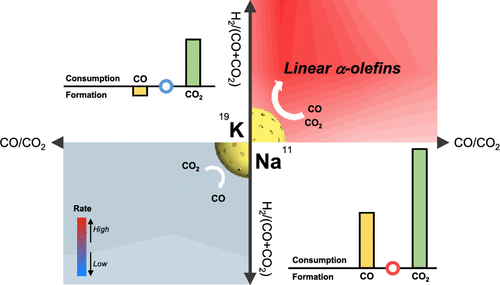当前位置:
X-MOL 学术
›
ACS Catal.
›
论文详情
Our official English website, www.x-mol.net, welcomes your feedback! (Note: you will need to create a separate account there.)
Comparative Study of Olefin Production from CO and CO2 Using Na- and K-Promoted Zinc Ferrite
ACS Catalysis ( IF 12.9 ) Pub Date : 2020-08-25 , DOI: 10.1021/acscatal.0c02429 Sunkyu Yang 1, 2 , Hee-Joon Chun 3 , Sungwoo Lee 1 , Seung Ju Han 1 , Kwan-Young Lee 2 , Yong Tae Kim 1
ACS Catalysis ( IF 12.9 ) Pub Date : 2020-08-25 , DOI: 10.1021/acscatal.0c02429 Sunkyu Yang 1, 2 , Hee-Joon Chun 3 , Sungwoo Lee 1 , Seung Ju Han 1 , Kwan-Young Lee 2 , Yong Tae Kim 1
Affiliation

|
Using a zinc ferrite catalyst system, we investigated the effect of sodium and potassium promoters on the concurrent conversion of CO and CO2 to olefins, focusing on the productivity and product distribution. We found that the use of promoters alters the balance between iron oxides and iron carbides in the catalyst, which affects the CO and CO2 conversion. The Na- and K-promoted catalysts facilitated the production of C2–C32 olefins, and a parametric study with 12 feedstock compositions (CO/CO2 = 0.2–5 and H2/(CO + CO2) = 1–3) revealed that the Na/Fe-Zn catalyst exhibited a 6.1-times higher apparent CO consumption rate and 2.7-times higher apparent CO2 consumption rate than the K/Fe-Zn catalyst at 340 °C and 2.0 MPa. At a CO/CO2 ratio of 0.2 and H2/(CO + CO2) ratio of 2, the Na/Fe-Zn catalyst achieved the maximum linear α-olefin yield (17.9%) at 70.3% apparent CO conversion and 26.0% apparent CO2 conversion (58.4% higher than those of the K/Fe-Zn catalyst) over 200 h. The Na/Fe-Zn catalyst activity for apparent CO conversion was more than twice that of the K/Fe-Zn catalyst, and it also exhibited better reactivity in terms of chain growth probability and secondary reactions, such as isomerization and hydrogenation. Characterization experiments revealed that the spent Na/Fe-Zn catalyst contained 43.2% iron carbides (mainly Fe5C2), and these were distributed within 19 nm of the catalyst particle surface. In contrast, the spent K/Fe-Zn catalyst was mostly composed of core–shell-type iron carbides (74.3% Fe5C2 and 21.2% Fe7C3) surrounded by carbonate/carbonyl carbon species. H2O isotherms of the spent catalysts were studied to understand factors affecting CO adsorption and CO2 reactivity, and theoretical calculations were used to probe CO hydrogenation productivity. The reactivity of Na/Fe-Zn toward CO and CO2 was analyzed with respect to the temperature, pressure, weight hourly space velocities, and optimal olefin productivity.
中文翻译:

Na和K促进的锌铁氧体从CO和CO 2生产烯烃的比较研究
使用锌铁氧体催化剂体系,我们研究了钠和钾促进剂对同时将CO和CO 2转化为烯烃的影响,重点是生产率和产物分布。我们发现助催化剂的使用改变了催化剂中氧化铁和碳化铁之间的平衡,这影响了CO和CO 2的转化。Na和K促进的催化剂促进了C 2 -C 32烯烃的生产,并采用12种原料成分(CO / CO 2 = 0.2-5和H 2 /(CO + CO 2)= 1-3)进行了参数研究。)表明,Na / Fe-Zn催化剂的表观CO消耗速率高6.1倍,表观CO消耗高2.7倍在340°C和2.0 MPa下比K / Fe-Zn催化剂的消耗速率高2倍。在CO / CO 2比为0.2和H 2 /(CO + CO 2)比为2的情况下,Na / Fe-Zn催化剂在70.3%的表观CO转化率和26.0的表观转化率下实现了最大线性α-烯烃产率(17.9%)。200小时内表观CO 2转化率(比K / Fe-Zn催化剂高58.4%)。Na / Fe-Zn催化剂在表观CO转化方面的活性是K / Fe-Zn催化剂的两倍以上,并且在链增长概率和诸如异构化和加氢等次级反应方面也表现出更好的反应性。表征实验表明,废Na / Fe-Zn催化剂含有43.2%的碳化铁(主要为Fe 5 C 2),并且它们分布在催化剂颗粒表面的19 nm以内。相反,用过的K / Fe-Zn催化剂主要由被碳酸盐/羰基碳物质包围的核壳型碳化铁(74.3%Fe 5 C 2和21.2%Fe 7 C 3)组成。研究了废催化剂的H 2 O等温线,以了解影响CO吸附和CO 2反应性的因素,并使用理论计算来探讨CO加氢生产率。分析了Na / Fe-Zn对CO和CO 2的反应性,涉及温度,压力,重时空速和最佳烯烃生产率。
更新日期:2020-09-20
中文翻译:

Na和K促进的锌铁氧体从CO和CO 2生产烯烃的比较研究
使用锌铁氧体催化剂体系,我们研究了钠和钾促进剂对同时将CO和CO 2转化为烯烃的影响,重点是生产率和产物分布。我们发现助催化剂的使用改变了催化剂中氧化铁和碳化铁之间的平衡,这影响了CO和CO 2的转化。Na和K促进的催化剂促进了C 2 -C 32烯烃的生产,并采用12种原料成分(CO / CO 2 = 0.2-5和H 2 /(CO + CO 2)= 1-3)进行了参数研究。)表明,Na / Fe-Zn催化剂的表观CO消耗速率高6.1倍,表观CO消耗高2.7倍在340°C和2.0 MPa下比K / Fe-Zn催化剂的消耗速率高2倍。在CO / CO 2比为0.2和H 2 /(CO + CO 2)比为2的情况下,Na / Fe-Zn催化剂在70.3%的表观CO转化率和26.0的表观转化率下实现了最大线性α-烯烃产率(17.9%)。200小时内表观CO 2转化率(比K / Fe-Zn催化剂高58.4%)。Na / Fe-Zn催化剂在表观CO转化方面的活性是K / Fe-Zn催化剂的两倍以上,并且在链增长概率和诸如异构化和加氢等次级反应方面也表现出更好的反应性。表征实验表明,废Na / Fe-Zn催化剂含有43.2%的碳化铁(主要为Fe 5 C 2),并且它们分布在催化剂颗粒表面的19 nm以内。相反,用过的K / Fe-Zn催化剂主要由被碳酸盐/羰基碳物质包围的核壳型碳化铁(74.3%Fe 5 C 2和21.2%Fe 7 C 3)组成。研究了废催化剂的H 2 O等温线,以了解影响CO吸附和CO 2反应性的因素,并使用理论计算来探讨CO加氢生产率。分析了Na / Fe-Zn对CO和CO 2的反应性,涉及温度,压力,重时空速和最佳烯烃生产率。


























 京公网安备 11010802027423号
京公网安备 11010802027423号